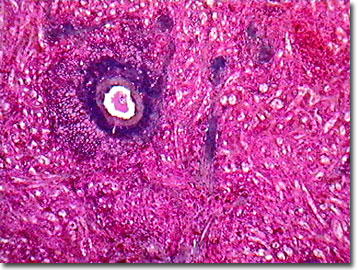Brightfield Digital Image Gallery
Human Spleen
When Shakespeare's Rosalind describes Cupid as "... conceived of spleen and born of madness ..." in his play As You Like It, she was referring to the spleen as an organ of spirit and courage and of such emotions as mirth, ill humor, and melancholy, and not as the filter and rejuvenator of human blood as anatomists know it. The human spleen is a highly vascular, glandular, and ductless organ (or gland to endocrinologists) situated at the cardiac end of the stomach. The important organ creates lymphocytes for the destruction and recycling of senile red-blood corpuscles (age of about 30 days). Similar functions are carried out by the liver. The spleen also acts as a blood reservoir, supplying blood in emergencies such as a bad cut.

The size and weight (average of 0.44 lbs, ranging between 0.17 to 0.66 pounds) of the adult human spleen varies extremely at different periods of life, in different individuals, and in the same individual under different conditions. With senescence, the dark purple organ not only becomes lighter, it becomes relatively smaller when compared to the rest of the body. During and after digestion, the size of the spleen increases, as it does in well-nourished mammals. However, during infection with malaria, a mosquito-borne disease, the spleen becomes highly enlarged and may weigh as much as 20 pounds.
In young spleens, giant cells exist, that contain multiple nuclei or a single compound nucleus, as well as some nucleated red-blood corpuscles. Splenic cells, large rounded cells that are capable of phagocytosis and that often contain red-blood cells and pigment in their interior, are often observed in the dark reddish-brown soft mass known as the splenic pulp. The pulp is actually a fine reticulum of fibers filled with red blood cells and a larger proportion of lymphocytes. When compared to other organs of the human body, the blood vessels that feed the spleen, particularly the lienal artery, are of remarkably large size. Sometimes smaller accessory spleens (in 10 percent of patients) or a doubled spleen are found during surgery, as are islands of pancreatic tissue within the spleen. However, accessory spleens are more often found within the tail of the pancreas. If it is removed during surgery, perhaps because of cancer, most patients fare well without their spleen. It remains "... one of the most obscure and mysterious corners of the human organism."
Contributing Authors
Cynthia D. Kelly, Thomas J. Fellers and Michael W. Davidson - National High Magnetic Field Laboratory, 1800 East Paul Dirac Dr., The Florida State University, Tallahassee, Florida, 32310.
BACK TO THE BRIGHTFIELD IMAGE GALLERY
BACK TO THE DIGITAL IMAGE GALLERIES
Questions or comments? Send us an email.
© 1995-2025 by Michael W. Davidson and The Florida State University. All Rights Reserved. No images, graphics, software, scripts, or applets may be reproduced or used in any manner without permission from the copyright holders. Use of this website means you agree to all of the Legal Terms and Conditions set forth by the owners.
This website is maintained by our
Graphics & Web Programming Team
in collaboration with Optical Microscopy at the
National High Magnetic Field Laboratory.
Last Modification Friday, Nov 13, 2015 at 01:19 PM
Access Count Since September 17, 2002: 16391
Visit the website of our partner in introductory microscopy education:
|
|
